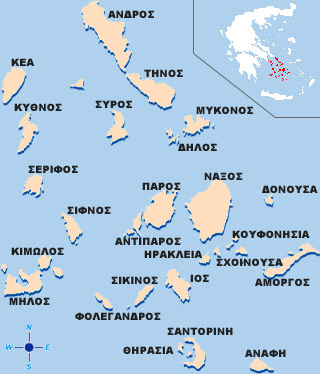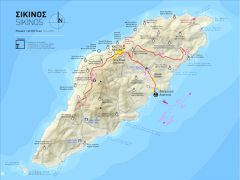Sikinos
Sikinos is a Cycladic island of the Aegean Sea, located between the islands of Folegandros and Ios and 14 and 10 miles respectively. From Piraeus is 102 miles away.
Sikinos has three settlements: Alopronia, Horio and Castle. Alopronia (als = sea + providence) is called the small port of Sikinos. In the seaside village of Alopronia there are supermarkets, hotels and rooms to let, cafes and bars. From here starts the bus to Chora and Episkopi and the caique for excursions to the remote beaches of Sikinos.
Castro, built on the edge of the cliff 280 meters above sea level, is an old fortified settlement of the 15th century. There is the square, the town hall, the doctor's office, the shops and the cafes. In the church of Pantanassa there is a gold-plated wood-carved icon screen. On the right, the church of Episkopi, which is about 4 km from the center of the island, is seen and used as a Christian church in the early Christian years of Sikinos. One of the main features of Sikinos is its chapels, 61 in number. There are six Byzantine churches (belonging to the type of single one-aisled basilica) with frescoes of the 13th and 14th centuries. It is Agios Nikolaos in Raches Katergos, Panagia in Sykia near Alopronia, Christ or Transfiguration of the Savior near Hora, Aghios Stefanos near Chorio, Agia Anna, chapel of Episkopi, and Agios Georgios near Episkopi.
 Geography
Geography
Its surface is estimated at 41,676 sq. Km. While it has a coastline of 40 km. The island's circumnavigation is 17 miles. Around the Sikinos are the following islets, north-west: Avoldas, Agios Georgios and Kardiotissa (the ancient Lagas), and southwest Kalogeros with many rocks, the most important of which is Karavos.
The main mountains of the island are Troulos (553m), Agios Mamas (549m), Agia Marina (450m) and the so-called "Monastery of the Monastery" (350m) where the Chrysopigi Monastery.
The main cove, which is also a port of the island, is located, is Alopronia. This bay, the oldest travelers, called it "San Bournia" from the name of the Catholic missionary Iacovus of Burnia who was also a doctor. This name is also used on old maps.
 Mythology
Mythology
According to Greek mythology, Sikinos was named after Sikinos by the son of Thoanta, the King of Lemnos, and his grandson Bacchos and Ariadne who lived in Naxos. Ypsippy, trying to save Thananda's son from the Lemnian women who caused the massacre of their spouses, hid him in a wooden urn and threw him into the sea. This drifting worm was dripped from the waves in Sikinos, where the fishermen of the area rescued the Thoanta. There Thaas married the native nymph Nisida with which he acquired Sikinos who reigned on the island.
According to Pliny and Stephan the Byzantine, the oldest name of this island was "Oinoi".
 The name Sikinos has been preserved since ancient times until today. It is only at the time of the Frankish period that for some time it is mocking at Skandros, as noted by the Florentine priest Christopher the Boudolomontis or Buentolmontis who visited the island in 1422 and says that its name is due to the many figs produced by the island. Sygicon also call Sikinos and Porcatsi in 1572, Markos Bossini in 1651, Piancenza in 1688 and others. Naval maps of the time mention Sikinos also with the names Zetine or Setine and Setin.
The name Sikinos has been preserved since ancient times until today. It is only at the time of the Frankish period that for some time it is mocking at Skandros, as noted by the Florentine priest Christopher the Boudolomontis or Buentolmontis who visited the island in 1422 and says that its name is due to the many figs produced by the island. Sygicon also call Sikinos and Porcatsi in 1572, Markos Bossini in 1651, Piancenza in 1688 and others. Naval maps of the time mention Sikinos also with the names Zetine or Setine and Setin.
Demography
Sikinos had 260 people in the 2011 census.
 Local products
Local products
Despite the fact that Sikinos, like all Cyclades, is not a region rich in rain, its inhabitants from the past years have been particularly engaged in cultivation, grazing, fishing, beekeeping and dairy. In the agricultural part of the production there are, especially during the summer months, vines, cucumbers in a round shape (similar but in a more protracted form are those of Santorini). Sikinos also produces a variety of cheeses, sour milk, dry mizithra, fresh mizithra cheese and sikinio cheese. Sikinos also has thyme honey, of which, along with sesame, is produced pasteli. Also, during the summer months, there are a variety of fish that fishermen bring to the island (such as barges, athletes, marionettes, laps, scorpions, etc.). Oil, vinegar and wine are produced in smaller quantities and usually involve self-consumption.












